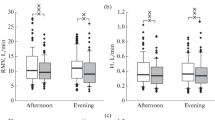Abstract
Changes in the power and coherence of α activity and heart rate variability (HRV) were studied in students with different performance levels in logical tasks. The students achieving high results in cognitive tests exhibited higher liability of α activity and HRV; the values and their ratios varied among the stages of intellectual activity. In these subjects, a decrease in the spectral power of the α band was more pronounced than in other groups. We also observed changes in the interhemispheric coherence and the structure of coherent interactions in the α band at different stages of task performance. In contrast, the number and structure of coherent interactions in individuals who exhibited lower results did not significantly vary at different stages of task performance. Compared to this group, the students with higher test results exhibited a more pronounced decreased in the total spectral power (TP) and an increase in the low frequency to high frequency (LF/HF) ratio, which returned to the initial level after the completion of the tests. In the students with better results in these cognitive tests, the dynamics of RRNN, TP, HF, and LF/HF during task performance were correlated with the dynamics of interhemispherical α band coherence.
Similar content being viewed by others
References
Sudakov, K.V., Dzhebrailova, T.D., and Korobeinikova, I.I., Geometric images of coherent relations of the a rhythm of electroencephalogram in the dynamics of systemic efficiency of human activity, Ross. Fiziol. Zh. im. I.M. Sechenova, 2011, vol. 97, no. 6, p. 580.
Dzhebrailova, T.D. and Korobeinikova, I.I., Spatial organization of EEG β-2 rhythm and efficiency of human cognitive activity, Zh. Vyssh. Nervn. Deyat. im. I.P. Pavlova, 2013, vol. 63, no. 6, p. 667.
Dzhebrailova, T.D., Suleimanova, R.G., Ivanova, L.I., and Ivanova, L.V., Individual specificity of purposive activity in students performing computer-aided tests, Hum. Physiol., 2012, vol. 38, no. 5, p. 50.
Dzhebrailova, T.D., Korobeinikova, I.I., Dudnik, E.N., and Karatygin, N.A., Autonomic correlates of individual differences in human intellectual activity, Hum. Physiol., 2013, vol. 39, no. 1, p. 78.
Bayevskiy, R.M., Problems of assessment and prediction of the functional state of body and its development in space medicine, Usp. Fiziol. Nauk, 2006, vol. 37, no. 3, p. 42.
Riganello, F., Candelieri, A., Quintieri, M., et al., Heart rate variability: An index of brain processing in autonomic state? An artificial intelligence, data mining study, Clin. Neurophysiol., 2010, vol. 121, no. 12, p. 2024.
Mashin, V.A., Variabel’nosti serdechnogo ritma: Trekhfaktornaya model' VSR v issledovaniyakh funktsional’nykh sostoyanii cheloveka (Heart Rate Variability: The Three-factor Model of HRV in Investigations of Human Functional States), lambert Academic Publishing, 2012.
Robinson, D., Sex differences in brain activity. Personality and intelligence: A test of arousability theory, Person. Indiv. Diff., 1998, vol. 25, p. 1133.
Klimesch, W., Sauseng, P., and Hanslmayr, S., EEG a oscillations: The inhibition-timing hypothesis, Brain Res. Rev., 2007, vol. 53, no. 1, p. 63.
Bazanova, A.M., The modern interpretation of a activity of electroencephalogram, Usp. Fiziol. Nauk, 2009, vol. 40, no. 3, p. 32.
Ohtake, Y., Hamada, T., Murata, T., Takahashi, T., Wada, Y., Kimura, H., and Yoshida, H., The association between autonomic response status and the changes in EEG activity during mental arithmetic task, Rinsho Byori, 2007, vol. 55, no. 12, p. 1075.
Yu, X., Zhang, J., Xie, D., Wang, J., and Zhang, C., Relationship between scalp potential and autonomic nervous activity during a mental arithmetic task, Auton. Neurosci., 2009, vol. 146, nos. 1–2, p. 81.
Bazanova, O.M., Balioz, N.V., Muravleva, K.B., and Skoraya, M.V., Effect of voluntary EEG power increase training on heart rate variability, Hum. Physiol., 2013, vol. 39, no. 1, p. 86.
Osnovy psikhologii (Bases of Psychology), Stolyarenko, L.D., Ed., Rostov-on-Don: Fenix, 2000.
Heart Rate Variability. Standards of Measurement. Physiological Interpretation and Clinical Use. Task Force of the European Society of Cardiology and the North American Society of Pacing and Electrophysiology, Circulation, 1996, vol. 93, no. 5, p. 1043.
Mikhailov, V.M., Variabel’nost’ ritma serdtsa: opyt prakticheskogo primeneniya metoda (Heart Rate Variability: Experience of Practical Application of the Method), Ivanovo: Ivan. Gos. Med. Akademiya, 2002.
Kotel’nikov, S.A., Nozdrachev, A.D., Odinak, M.M., Shustov, E.B., Kovalenko, I.Yu., and Davydenko, V.Yu., Cardiac rhythm variability: Approaches to mechanisms, Hum. Physiol., 2002, vol. 28, no. 1, p. 114.
Andrianov, V.V., Vasilyuk, N.A., Biryukova, E.V., and Kazakova, V.V., Physiological indices of students performing educational tests, Sechenovskii Vestn., 2013, no. 4 (14), p. 35.
Klimesch, W., EEG α and β oscillations reflect cognitive and memory performance: A review and analysis, Brain Res. Rev., 1999, vol. 29, nos. 2–3, p. 169.
Bechtereva, N.P. and Nagornova, Zh.V., Changes of EEG coherence during tests for nonverbal (figurative) creativity, Hum. Physiol., 2007, vol. 33, no. 5, p. 515.
Fassbender, C., Simoes-Franklin, C., Murphy, K., Hester, R., Meaney, J., Robertson, I.H., and Garavan, H., The role of a right fronto-parietal network in cognitive control: Common activations for “cues-to-attend” and response inhibition, J. Psychophysiol., 2006, vol. 20, no. 4, p. 286.
Machinskaya, R.I. and Kurganskii, A.V., A comparative electrophysiological study of regulatory components of working memory in adults and 7to 8-year-old children: Analysis of coherence of EEG rhythms, Hum. Physiol., 2012, vol. 38, no. 1, p. 1–33.
Heller, W. and Nitschke, J.B., Regional brain activity and emotion: A framework for understanding cognition in depression, Cognit. Emot., 1997, vol. 11, nos. 5–6, p. 637.
Author information
Authors and Affiliations
Corresponding author
Additional information
Original Russian Text © T.D. Dzhebrailova, I.I. Korobeinikova, N.A. Karatygin, E.N. Dudnik, 2015, published in Fiziologiya Cheloveka, 2015, Vol. 41, No. 6, pp. 36–48.
Rights and permissions
About this article
Cite this article
Dzhebrailova, T.D., Korobeinikova, I.I., Karatygin, N.A. et al. Dynamics of EEG α activity and heart rate variability in subjects performing cognitive tests. Hum Physiol 41, 599–610 (2015). https://doi.org/10.1134/S0362119715040076
Received:
Published:
Issue Date:
DOI: https://doi.org/10.1134/S0362119715040076




